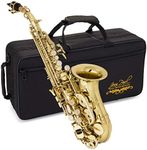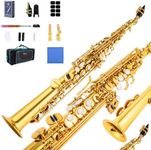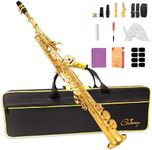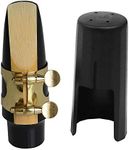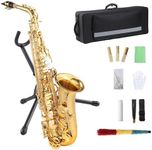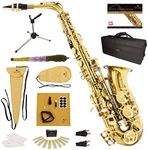Buying Guide for the Best Soprano Saxophones
Choosing the right soprano saxophone can be a rewarding experience, whether you're a beginner or an experienced player. The key to finding the best fit for you lies in understanding the various specifications and how they align with your personal needs and playing style. By focusing on the key specs, you can make an informed decision that will enhance your musical journey.MaterialThe material of a soprano saxophone affects its sound and durability. Most saxophones are made from brass, but they can also be found in bronze, copper, or even silver. Brass is the most common and offers a bright, versatile sound. Bronze and copper can provide a warmer tone, while silver can add a unique timbre. Beginners might prefer brass for its balance of quality and affordability, while more advanced players might explore other materials to achieve a specific sound.
FinishThe finish of a soprano saxophone not only impacts its appearance but also its sound. Lacquer finishes are common and provide a bright, clear tone. Silver plating can enhance the instrument's projection and add a bit of warmth to the sound. Gold plating is less common and more expensive, offering a rich, warm tone. Choose a finish that complements your desired sound and aesthetic preferences.
Key MechanismThe key mechanism of a soprano saxophone determines how comfortable and responsive the instrument is to play. High-quality key mechanisms offer smooth action and precise intonation. Beginners should look for a saxophone with a reliable and easy-to-use key mechanism to facilitate learning. Advanced players might seek out more sophisticated mechanisms that allow for greater expression and technical proficiency.
Bore SizeThe bore size of a soprano saxophone affects its sound and playability. A larger bore can produce a fuller, richer sound but may require more air support. A smaller bore offers easier playability and a brighter tone, which can be beneficial for beginners. Consider your lung capacity and the type of music you want to play when choosing the bore size.
MouthpieceThe mouthpiece is a crucial component of the soprano saxophone, influencing the instrument's tone and playability. Mouthpieces come in various shapes and materials, with hard rubber and metal being the most common. Hard rubber mouthpieces generally produce a warmer, more mellow sound, while metal mouthpieces offer a brighter, more powerful tone. Beginners should start with a standard mouthpiece that provides a good balance of comfort and sound, while advanced players might experiment with different mouthpieces to find their ideal tone.
IntonationIntonation refers to the accuracy of the pitch produced by the soprano saxophone. Good intonation is essential for playing in tune with other musicians. High-quality saxophones are designed to have better intonation, but it also depends on the player's skill and the mouthpiece used. Beginners should look for a saxophone known for its reliable intonation to help develop their ear and playing technique. Advanced players might prioritize instruments with exceptional intonation for professional performance.
ErgonomicsErgonomics refers to how comfortable the soprano saxophone is to hold and play. A well-designed saxophone will have keys that are easy to reach and a weight that is manageable for the player. This is especially important for younger or smaller players who may struggle with larger, heavier instruments. Try holding and playing different models to see which one feels the most comfortable and natural in your hands.


